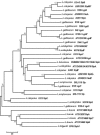Lactobacillus surface layer proteins: structure, function and applications
- PMID: 23677442
- PMCID: PMC3666127
- DOI: 10.1007/s00253-013-4962-2
Lactobacillus surface layer proteins: structure, function and applications
Abstract
Bacterial surface (S) layers are the outermost proteinaceous cell envelope structures found on members of nearly all taxonomic groups of bacteria and Archaea. They are composed of numerous identical subunits forming a symmetric, porous, lattice-like layer that completely covers the cell surface. The subunits are held together and attached to cell wall carbohydrates by non-covalent interactions, and they spontaneously reassemble in vitro by an entropy-driven process. Due to the low amino acid sequence similarity among S-layer proteins in general, verification of the presence of an S-layer on the bacterial cell surface usually requires electron microscopy. In lactobacilli, S-layer proteins have been detected on many but not all species. Lactobacillus S-layer proteins differ from those of other bacteria in their smaller size and high predicted pI. The positive charge in Lactobacillus S-layer proteins is concentrated in the more conserved cell wall binding domain, which can be either N- or C-terminal depending on the species. The more variable domain is responsible for the self-assembly of the monomers to a periodic structure. The biological functions of Lactobacillus S-layer proteins are poorly understood, but in some species S-layer proteins mediate bacterial adherence to host cells or extracellular matrix proteins or have protective or enzymatic functions. Lactobacillus S-layer proteins show potential for use as antigen carriers in live oral vaccine design because of their adhesive and immunomodulatory properties and the general non-pathogenicity of the species.
Figures

Similar articles
-
Lactobacillus surface layers and their applications.FEMS Microbiol Rev. 2005 Aug;29(3):511-29. doi: 10.1016/j.femsre.2005.04.003. FEMS Microbiol Rev. 2005. PMID: 15935509 Review.
-
Conserved S-Layer-Associated Proteins Revealed by Exoproteomic Survey of S-Layer-Forming Lactobacilli.Appl Environ Microbiol. 2015 Oct 16;82(1):134-45. doi: 10.1128/AEM.01968-15. Print 2016 Jan 1. Appl Environ Microbiol. 2015. PMID: 26475115 Free PMC article.
-
Characterization of a S-layer protein from Lactobacillus crispatus K313 and the domains responsible for binding to cell wall and adherence to collagen.Appl Microbiol Biotechnol. 2013 Mar;97(5):1941-52. doi: 10.1007/s00253-012-4044-x. Epub 2012 Apr 18. Appl Microbiol Biotechnol. 2013. PMID: 22526799
-
Domains in the S-layer protein CbsA of Lactobacillus crispatus involved in adherence to collagens, laminin and lipoteichoic acids and in self-assembly.Mol Microbiol. 2002 Oct;46(2):381-94. doi: 10.1046/j.1365-2958.2002.03180.x. Mol Microbiol. 2002. PMID: 12406216
-
[Biological properties of Lactobacillus surface proteins].Postepy Hig Med Dosw (Online). 2013 Apr 4;67:229-37. doi: 10.5604/17322693.1043393. Postepy Hig Med Dosw (Online). 2013. PMID: 23619222 Review. Polish.
Cited by
-
Characterization of the first vaginal Lactobacillus crispatus genomes isolated in Brazil.PeerJ. 2021 Mar 10;9:e11079. doi: 10.7717/peerj.11079. eCollection 2021. PeerJ. 2021. PMID: 33854845 Free PMC article.
-
Nanobodies as potential tools for microbiological testing of live biotherapeutic products.AMB Express. 2024 Jan 20;14(1):9. doi: 10.1186/s13568-023-01659-z. AMB Express. 2024. PMID: 38245586 Free PMC article.
-
Microbial Delivery Vehicles for Allergens and Allergen-Derived Peptides in Immunotherapy of Allergic Diseases.Front Microbiol. 2018 Jul 2;9:1449. doi: 10.3389/fmicb.2018.01449. eCollection 2018. Front Microbiol. 2018. PMID: 30013543 Free PMC article. Review.
-
Lactobacillus spp. for Gastrointestinal Health: Current and Future Perspectives.Front Immunol. 2022 Apr 6;13:840245. doi: 10.3389/fimmu.2022.840245. eCollection 2022. Front Immunol. 2022. PMID: 35464397 Free PMC article. Review.
-
Inflammatory Bowel Diseases and Gut Microbiota.Int J Mol Sci. 2023 Feb 14;24(4):3817. doi: 10.3390/ijms24043817. Int J Mol Sci. 2023. PMID: 36835245 Free PMC article. Review.
References
-
- Altermann E, Russell WM, Azcarate-Peril A, Barrangou R, Buck BL, McAuliffe O, Souther N, Dobson A, Duong T, Callanan M, Lick S, Hamrick A, Cano R, Klaenhammer TR. Complete genome sequence of the probiotic lactic acid bacterium Lactobacillus acidophilus NCFM. PNAS. 2005;102:3906–3912. doi: 10.1073/pnas.0409188102. - DOI - PMC - PubMed
-
- Ausiello CM, Cerquetti M, Fedele G, Spensieri F, Palazzo R, Nasso M, Frezza S, Mastrantonio P. Surface layer proteins from Clostridium difficile induce inflammatory and regulatory cytokines in human monocytes and dendritic cells. Microbes Infect. 2006;8:2640–2646. doi: 10.1016/j.micinf.2006.07.009. - DOI - PubMed
Publication types
MeSH terms
Substances
LinkOut - more resources
Full Text Sources
Other Literature Sources
Molecular Biology Databases
Research Materials
Miscellaneous

